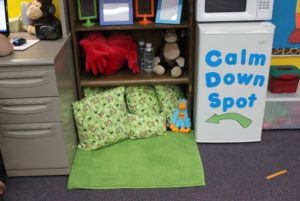Have you ever heard of a classroom quiet zone? Want to learn more? Read on…
We’ve outlined some important elements about using quiet zones in the classroom.
What is a Quiet Zone?
This is an area in the classroom dedicated to providing a calming, quiet, distraction-free zone. Students can use the quiet zone to work, read, or think. It can be a place for students to get caught up on work, take a test, draw, calm down, manage emotions, or just to be alone. Ultimately, the idea is to provide an area where students can get their emotions in check and return to the classroom ready to work.
What Does a Classroom Quiet Zone Look Like?
The quiet zone space should be well-defined. Use study carrels, curtains, tent, or shelves to keep visual distractions to a minimum. Provide a table or desk with a chair. Or, make it a more comfortable and inviting space with a small couch or large pillows. A rug completes the area and provides a clear outline for the space.
What Else Should Be In The Quiet Zone?
You can provide basic supplies, like books, pencils, paper, coloring utensils, clipboard, etc. Stress-relieving tools like squishy balls, fidget toys, stuffed animals. Additionally, to block out noise distraction, offer headphones, or noise-canceling headphones.
What Rules Should The Quiet Zone Have?
Only one student at a time in the quiet zone. A time limit should be implemented; 5 minutes is the suggested time for a student taking a mental health break. Keep a timer in the quiet zone and teach students to operate it. When time is up, students should rejoin the class. If more time is needed, it may be a good idea to process with the student after their stay as there might be a deeper issue that needs to be addressed. A quiet zone is not a punishment and should not be treated as such. The quiet zone should not be a place for students to avoid work.
When Should A Student Go To The Quiet Zone?
When a student: feels overwhelmed, seems distracted, has trouble with a classmate, feels upset, or just needs a quick break from work. The reasons are truly endless. Don’t we all need a short break from time to time?
What Are The Benefits To Having A Quiet Zone in the Classroom?
The most obvious benefit of having a quiet zone is helping students learn to manage emotions. When students recognize something isn’t right, they can comfort themselves using the quiet zone. Also, a quiet zone helps students control their behavior and emotions rather than acting out during class.
Check out some of these calming, classroom quiet zones:
By Lisa Mongold – from the blog “On The Sunny Side”
By Kayla Marston from the blog “The School Counselor Kind”
Our Education Blogger is a public school teacher with over a decade of experience. She’s an active NEA member and enjoys writing about her experiences in the classroom.
Click here to learn more about how California Casualty supports Education Professionals.
This article is furnished by California Casualty, providing auto and home insurance to educators, law enforcement officers, firefighters, and nurses. Get a quote at 1.866.704.8614 or www.calcas.com.
- Educators Receive $1,000 Athletic Grants from California Casualty - May 22, 2024
- Music & Arts Grant Recipients – 2023 - December 1, 2023
- How to Tell When You Need New Brakes - November 20, 2023



